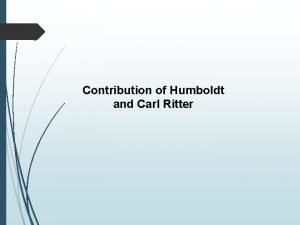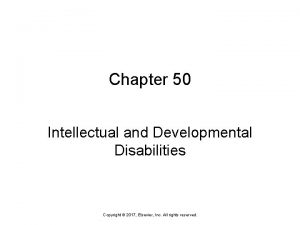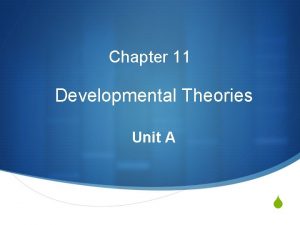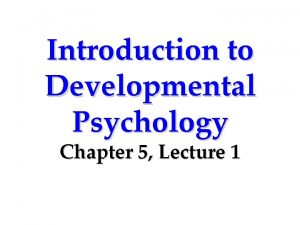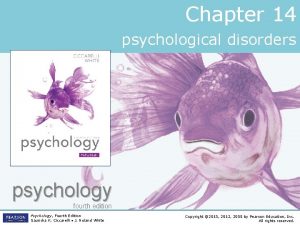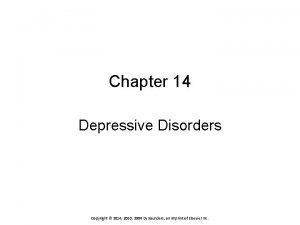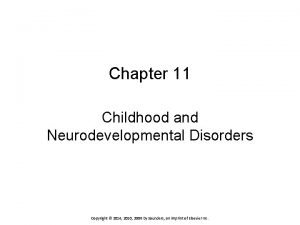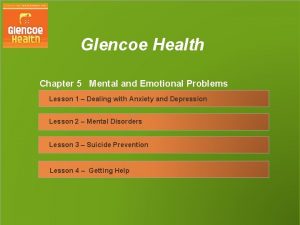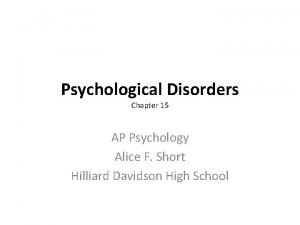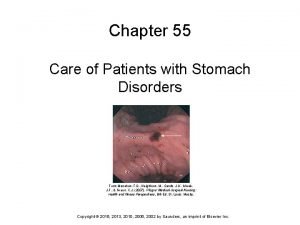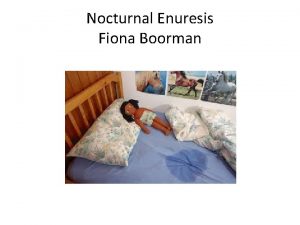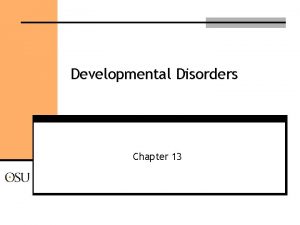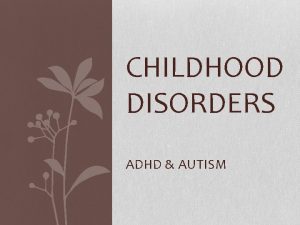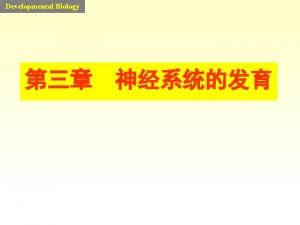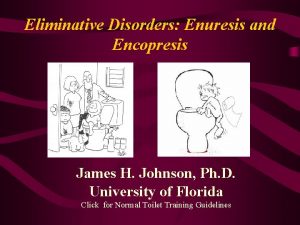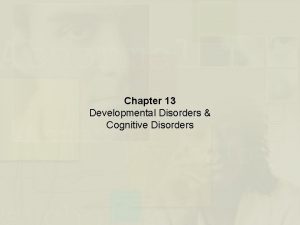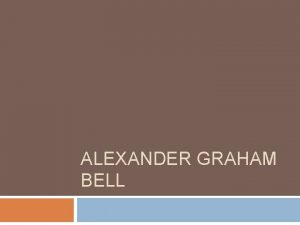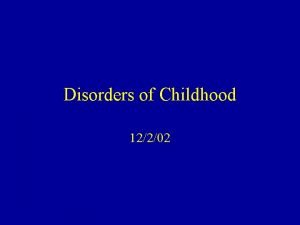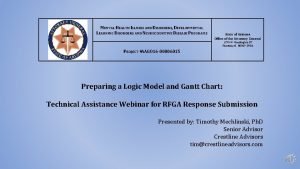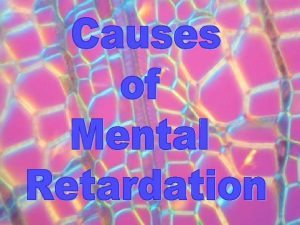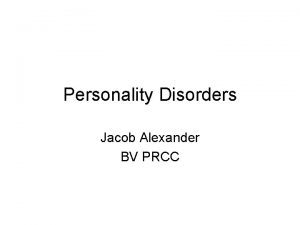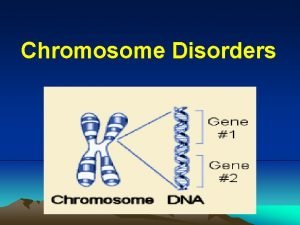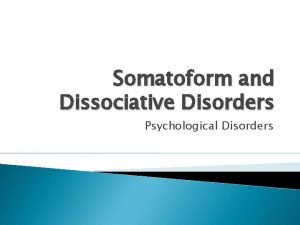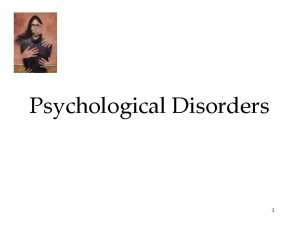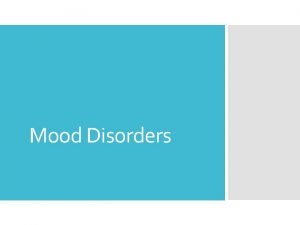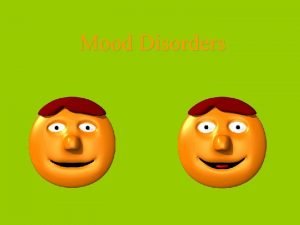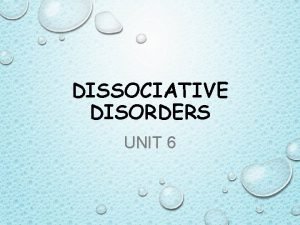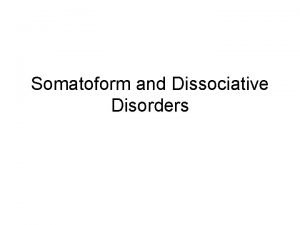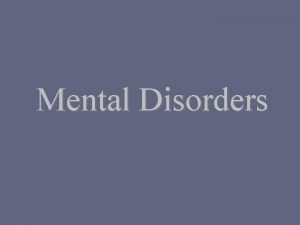DEVELOPMENTAL DISORDERS Chapter C 4 ENURESIS Alexander von


































- Slides: 34

DEVELOPMENTAL DISORDERS Chapter C. 4 ENURESIS Alexander von Gotard DEPRESSION IN CHILDREN AND ADOLESCENTS Companion Power. Point Presentation Adapted by Julie Chilton

The “IACAPAP Textbook of Child and Adolescent Mental Health” is available at the IACAPAP website http: //iacapap. org/iacapap-textbook-of-child-and-adolescentmental-health Please note that this book and its companion powerpoint are: · Free and no registration is required to read or download it · This is an open-access publication under the Creative Commons Attribution Noncommercial License. According to this, use, distribution and reproduction in any medium are allowed without prior permission provided the original work is properly cited and the use is non-commercial.

Enuresis Outline • Definition and classification • Epidemiology • Clinical presentations • Etiology and risk factors • Comorbidity • Diagnosis • Treatment

Enuresis The Basics • Very common • Occurs worldwide at same rate • 7 year olds • 10% at night • 2 -3% during the day • Adolescents • 1 -2% at night • <1% during the day • Vast majority are functional • 20 -40% comorbid disorders • Most treated with counseling and CBT

Enuresis Definition


Enuresis Outline

Enuresis Approximate Normal Values in Childhood • Micturition frequency: 5 -7 times per day • Voided volumes: (age + one) multiplied by 30 ml

Enuresis Epidemiology of Enuresis • 2 -3 times more common than daytime urinary incontinence • 1. 5 to 2 times more common in boys • Prevalence decreases with age • • 20% of 4 year olds 10% of 7 year olds 1 -2% of adolescents 0. 3 -1. 7% of adults • Primary more common than secondary • Monosymptomatic twice as common as nonmonosymptomatic • Daytime urinary incontinence 1. 5 x more common in girls • Urge incontinence is most common • Voiding postponement second most common

Enuresis Worldwide Prevalence • 4% Chinese children and adolescents 6 -16 years old • 8% Taiwanese children aged 6 -11 years • 15% Turkish children aged 5 -7 years • 15% children and adolescents in Saudi Arabia • 17% of 7 year olds in Sudan • 21% Ethiopian children and adolescents aged 6 -15 years (including daytime incontinence)

Enuresis Clinical Presentations: Monosymptomatic Enuresis • • Deep sleep and difficult arousal Increased urine volume at night Large wetted volumes Normal bladder function during the day

Enuresis Clinical Presentation: Non-Monosymptomatic Enuresis • Similar nighttime symptoms of monosymptomatic enuresis • Daytime urinary incontinence (except wetting) • May also have UTIs, constipation and encopresis

Enuresis Clinical Presentation: Secondary Enuresis • Comorbid behavioral and emotional disorders • Stressful life events can cause relapse – Separation or divorce of parents – Birth of sibling • Otherwise, no difference from primary enuresis

Enuresis Clinical Presentation: Urge Incontinence • High micturition frequency – More than 7 x a day – Short intervals in between • • • Urge symptoms Incontinence with small micturition volumes Holding maneuvers Vulvovaginitis, perigenital dermatitis Urinary tract infections

Enuresis Clinical Presentation: Voiding Postponement Low micturition frequency: < 5 times a day Postponement in certain situations Holding maneuvers till wetting unavoidable Stool retention, constipation, encopresis Repeated straining Intermittent and fractioned flow Incomplete bladder emptying with residual urine and UTIs • Vesico-ureteral reflux • •

Enuresis Etiology and Risk Factors • Monosymptomatic enuresis: marked genetic component • Urge incontinence: marked genetic component • Secondary enuresis: genetic and environmental • Voiding postponement: mostly environmental

Enuresis Etiology and Risk Factors: Enuresis • Genetically determined maturational disorder of the central nervous system • 70 -80% have affected relatives • Concordance rates: monozygotic > dizygotic twins • Most autosomal dominant inheritance • Loci on chromosomes 12, 13, 22 • Neurological soft signs • Longer to complete motor tasks • Sleep architecture not affected • Mean latency = 3 hours

Enuresis Main Mechanisms for Development Increased urine volume in some Circadian variation of antidiuretic hormone Impaired arousal Inhibition deficit of pontine micturition centre of brainstem • Type of toilet training has no effect • Psychosocial factors bigger role in secondary enuresis • •

Enuresis Etiology and Risk Factors: Urinary Incontinence OR > 3 if mother affected OR > 10 if father affected Positive linkage to chromosome 17 Urge incontinence: spontaneous contractions of detrusor • Giggle incontinence has genetic factor • Voiding postponement due to acquired habit or oppositionality • •

Enuresis Comorbidity : Enuresis • Psychological disorders 25 x greater in children with elimination disorders • Especially with secondary enuresis and nonmonosymptomatic enuresis • Most common comorbidity: ADHD • Rates slightly higher with daytime incontinence Also common: • Separation anxiety • Social anxiety • Specific phobia • Generalized anxiety • Depression • ODD • Conduct disorders • ADHD

Enuresis Diagnosis Standard: • History • 48 hour frequency/volume chart • Questionnaires • Pediatric physical exam • Urinalysis • Child psychiatric screening/assessment • Sonography (if available) If indicated: • Urine bacteriology • Uroflowmetry and pelvic floor EMG • Radiological exams • Invasive urodynamics • Cystoscopy



Enuresis General Principles of Treatment • Overall: non-pharmacological interventions>medication • Treat only after age 5 • Treatment should be symptom oriented • Primary psychotherapy is not effective • Treat comorbidities separately • Treat encopresis and constipation first • Treat daytime incontinence first • Treat primary and secondary enuresis in same way

Enuresis Initial Treatment Steps • • • Counseling, support, information Enhance motivation Alleviate guilt Education: drinking and toileting Discontinue all ineffective measures – Punishment – Fluid restrictions – Waking and lifting – Ineffective medication – Alternative medicines • Record wet and dry nights for 4 weeks


Enuresis Alarm Treatment

Enuresis Medication Indications • • • Unwillingness for alarm treatment Lack of motivation Overwhelmed family Short-term dryness required quickly 2 medication choices: – Desmopressin (preferred) – Tricyclic antidepressants

Enuresis Medication: Desmopressin • (DDAVP) • Synthetic antidiuretic hormone • Effective in 70% of cases • Relapse common after discontinuation • Tablet form in evening • 0. 2 mg-0. 4 mg titrated over 4 weeks • Stop after 12 weeks; may repeat • Monitor for hyponatremia • Otherwise well tolerated


Enuresis Treatment: Urinary Incontinence • • • Urge toilet (no holding) Wet/dry chart Go to toilet in any situation Works in 1/3 Other 2/3: oxybutine – 0. 3 -0. 6 mg/kg per day in 3 doses – Max daily: 15 mg – Dose dependent, reversible side effects – Flushing, blurred vision, tachycardia, hyperactivity, dry mouth, residual urine, constipation

Enuresis Course • Excellent long-term outcome • 13% spontaneous remission rate per year • 60 -80% become dry with alarm treatment; 50% dry long-term • 1 -2% adolescents have long-term enuresis • Adult prevalence <2% • Urge incontinence has best prognosis

Enuresis Further Resources http: //i-c-c-s. org/ https: //www. nice. org. uk/guidance/cg 111

Enuresis Thank You!
 Difference between enuresis and encopresis
Difference between enuresis and encopresis Oral pathology
Oral pathology Humboldt ritter
Humboldt ritter Humboldt ausbildung
Humboldt ausbildung Kurshalter
Kurshalter Erasmus von rotterdam beeinflusst von
Erasmus von rotterdam beeinflusst von Chapter 50 intellectual and developmental disabilities
Chapter 50 intellectual and developmental disabilities Chapter 11 developmental theories
Chapter 11 developmental theories Chapter 5 developmental psychology
Chapter 5 developmental psychology Medical model psychology
Medical model psychology Concept mapping chapter 11 genetic disorders
Concept mapping chapter 11 genetic disorders Retention hyperkeratosis dermnet
Retention hyperkeratosis dermnet Chapter 6 musculoskeletal system
Chapter 6 musculoskeletal system Chapter 46 digestive and endocrine disorders
Chapter 46 digestive and endocrine disorders Types of somatic disorder
Types of somatic disorder Chapter 29 endocrine and metabolic disorders
Chapter 29 endocrine and metabolic disorders Chapter 21 mental health diseases and disorders
Chapter 21 mental health diseases and disorders Chapter 18 psychological disorders
Chapter 18 psychological disorders Chapter 18 eating and feeding disorders
Chapter 18 eating and feeding disorders Chapter 17 reproductive system diseases and disorders
Chapter 17 reproductive system diseases and disorders Chapter 15 nervous system diseases and disorders
Chapter 15 nervous system diseases and disorders Chapter 15 anxiety and obsessive-compulsive disorders
Chapter 15 anxiety and obsessive-compulsive disorders Chapter 14 psychological disorders
Chapter 14 psychological disorders Chapter 14 depressive disorders
Chapter 14 depressive disorders Chapter 11 childhood and neurodevelopmental disorders
Chapter 11 childhood and neurodevelopmental disorders Chapter 5 lesson 2 mental disorders
Chapter 5 lesson 2 mental disorders Chapter 8 skin disorders and diseases
Chapter 8 skin disorders and diseases Chapter 5 mental and emotional problems answer key
Chapter 5 mental and emotional problems answer key What condition do fungal organisms favor for growth
What condition do fungal organisms favor for growth Milady chapter 10 nail disorders and diseases
Milady chapter 10 nail disorders and diseases Chapter 8 cardiovascular system
Chapter 8 cardiovascular system Milady chapter 8 skin disorders and diseases
Milady chapter 8 skin disorders and diseases Chapter 14 psychological disorders
Chapter 14 psychological disorders Ap psychology chapter 15
Ap psychology chapter 15 Chapter 55 care of patients with stomach disorders
Chapter 55 care of patients with stomach disorders


